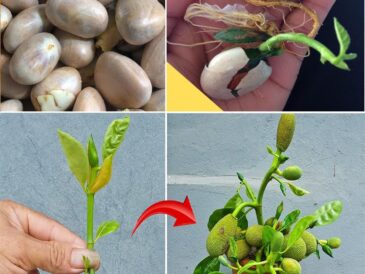Growing an apple plant at home is not only a rewarding hobby but also a sustainable way to enjoy fresh, organic apples right from your backyard or even a small indoor space. If you’ve ever wondered how to cultivate an apple plant starting from a simple apple fruit, you’re in the right place. This detailed guide explores the best techniques, scientific insights, and practical tips to successfully grow an apple plant from apple seeds or fruit.
Whether you’re a seasoned gardener or a beginner eager to dive into fruit cultivation, this article will equip you with all the necessary knowledge. From seed extraction and germination to planting and care, we’ll walk you through every step for optimal growth and a fruitful harvest.
Table of Contents
- Why Grow Apple Plants at Home?
- Understanding Apple Plant Biology
- Best Apples for Home Planting
- Preparing Apple Seeds from Fruit
- Stratification: The Key to Successful Germination
- How to Germinate Apple Seeds at Home
- Soil Preparation and Ideal Growing Conditions
- Planting Your Apple Seedling
- Watering and Fertilizing Tips
- Managing Common Pests and Diseases
- Pruning and Training Your Apple Plant
- Transplanting and Repotting Considerations
- Harvesting Your First Apples
- Troubleshooting Common Problems
- Benefits of Growing Apples Indoors vs Outdoors
- Sustainable Practices for Long-Term Apple Cultivation
- FAQs about Growing Apple Plants from Fruit
- Conclusion: Your Journey to Homegrown Apples
1. Why Grow Apple Plants at Home?
Apples are one of the most beloved fruits worldwide due to their taste, nutritional value, and versatility. Growing your own apple plant offers several advantages:
- Freshness and Quality Control: Homegrown apples are free from pesticides and chemicals, ensuring healthier consumption.
- Cost Efficiency: Over time, growing your own apples can reduce grocery bills.
- Educational Experience: Cultivating a plant from seed provides invaluable gardening knowledge.
- Environmental Impact: Growing fruit at home reduces carbon footprints associated with commercial farming and transportation.
- Satisfaction and Enjoyment: Watching a seed grow into a fruit-bearing tree is deeply gratifying.
2. Understanding Apple Plant Biology
Before planting, it’s important to understand the biology of an apple tree (Malus domestica). Apple trees are deciduous, temperate-climate trees that require a period of dormancy (cold exposure) to thrive. Apples develop from flowers pollinated by insects, with seeds encased inside the fruit.
Apples grown from seeds do not always produce fruit identical to the parent due to genetic variation. However, growing from seed is an excellent way to cultivate rootstock or experiment with new varieties.
3. Best Apples for Home Planting
Not all apple varieties are equally suited for home planting. Here are some commonly recommended apples for growing from seed or grafting at home:
- Honeycrisp: Sweet, crisp, and popular for fresh eating.
- Fuji: Known for sweetness and longevity.
- Gala: Mild and aromatic, good for beginners.
- Granny Smith: Tart apples, great for cooking and baking.
- Red Delicious: Classic red apples with a sweet flavor.
Choose apples from organic sources when possible, to avoid seeds treated with chemicals.
4. Preparing Apple Seeds from Fruit
Step 1: Select a Healthy Apple
Choose a ripe, healthy apple from which to extract seeds. Avoid bruised or damaged fruit.
Step 2: Extract the Seeds
Cut the apple open and carefully remove the seeds from the core. Use clean hands or gloves to avoid contamination.
Step 3: Clean the Seeds
Rinse the seeds under running water to remove any fruit residue. Soak them briefly in water mixed with a small amount of hydrogen peroxide or vinegar to disinfect.
Step 4: Dry the Seeds
Place seeds on a paper towel and let them air dry for 24 hours in a cool, dry place.
5. Stratification: The Key to Successful Germination
Apple seeds require a process called stratification to mimic natural winter conditions and break seed dormancy. Without stratification, seeds may fail to germinate or take an excessively long time.
How to Stratify Apple Seeds at Home:
- Place clean, dry seeds in a plastic bag with a mixture of moist peat moss, vermiculite, or sand. The mixture should be damp but not soggy.
- Seal the bag and place it in the refrigerator (not freezer) at approximately 1–4°C (34–39°F).
- Leave the seeds in cold stratification for 6 to 8 weeks. Check periodically to ensure the medium remains moist.
- After stratification, seeds are ready for planting.
6. How to Germinate Apple Seeds at Home
Materials Needed:
- Seed-starting trays or small pots
- Quality seed-starting mix (light, well-draining)
- Labels and markers
- Spray bottle for watering
Germination Steps:
- Fill pots with seed-starting mix.
- Plant stratified seeds about 1/2 inch deep.
- Water gently with a spray bottle to moisten the soil.
- Cover pots with plastic wrap or a humidity dome to retain moisture.
- Place pots in a warm location (20–25°C or 68–77°F) with indirect sunlight.
- Keep the soil moist but not waterlogged.
- Germination typically occurs in 1 to 3 weeks.
7. Soil Preparation and Ideal Growing Conditions
Apples thrive in well-drained loamy soil with a pH between 6.0 and 7.0. For home planting:
- Ensure soil is rich in organic matter by mixing compost or aged manure.
- Avoid heavy clay or sandy soils that retain too much water or drain excessively.
- Provide good aeration by loosening the soil before planting.
- Ensure the planting location receives at least 6 to 8 hours of sunlight daily.
Click page 2 for more




